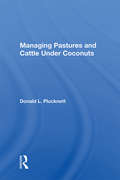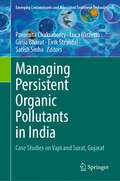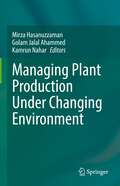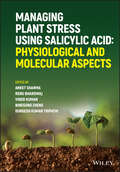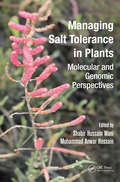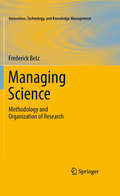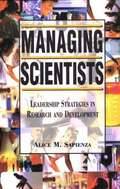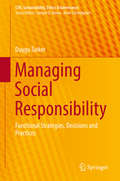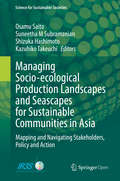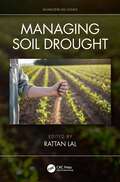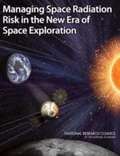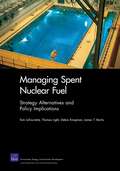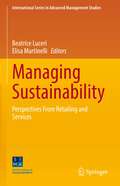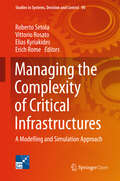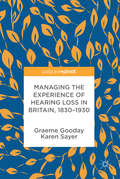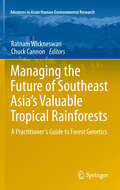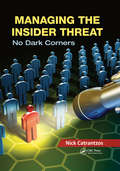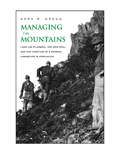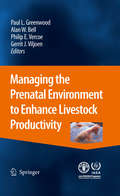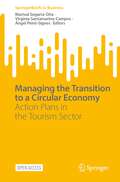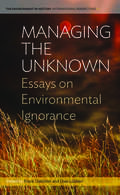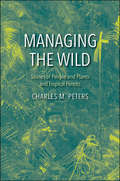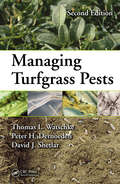- Table View
- List View
Managing Pastures And Cattle Under Coconuts
by Donald L. PlucknettBecause of the long life of a coconut palm--sixty to eighty years--and the relatively wide spacing the plants require, every coconut grower faces the problem of how to manage the land beneath the palms. Many of the small-scale farmers who manage over 90 percent of the 6 million hectares of coconut palms in the world have learned that raising cattle or other livestock under the palms can be profitable, as well as an effective method of controlling weeds. This book reviews current knowledge on this productive farming system, drawing on research results and experiences of successful farmers. Well illustrated with photographs from producing areas, the book includes information on the management of both natural (unimproved) and improved pastures.
Managing Persistent Organic Pollutants in India: Case Studies on Vapi and Surat, Gujarat (Emerging Contaminants and Associated Treatment Technologies)
by Paromita Chakraborty Luca Nizzetto Girija Bharat Eirik Steindal Satish SinhaPersistent Organic Pollutants (POPs) are a class of chemicals that are persistent, bio accumulative and toxic (PBT), which are restricted for use under the Stockholm Convention. They adversely impact the environment, human and animal health. Most of the POPs are semi-volatile organic compounds (SVOCs) and known to have a long-range transport potential and are often deposited in colder climate and found in places away from the regions they are produced. POPs are usually hydrophobic (i.e., “water-hating”) and lipophilic (i.e., “fat-loving”) chemicals, due to which they bind to solids, particularly organic matter, and fatty tissues in both marine and terrestrial environments. As a result, POPs may move up the food chain. This book focuses on determining the sources, fate, analytical techniques of detecting POPs as well as their health impacts. It further dwells on the regulatory aspects, management of POPs, best environmental practices (BEPs), Indian and international case studies, gaps in understanding the regulatory aspects. A few key recommendations for the way forward form the concluding chapters of this book.
Managing Plant Production Under Changing Environment
by Golam Jalal Ahammed Mirza Hasanuzzaman Kamrun NaharThis comprehensive edited volume collects the most recent information with up-to-date citations, on the decrease in plant productivity under climatic changes and its link with global food security. The book emphasis on the crop management practices and recent advancement in the techniques for mitigating the negative effects of climate induced biotic and abiotic stress. It brings together 19 chapters developed by eminent researchers in the area of plant and environmental sciences. Global climate change is increasingly becoming a concern for future of agriculture. High levels of inorganic and organic pollutants and climatic stress adversely affects the sensitive and complex equation of natural resources and ecosystem services. To meet the increased food demand, plant productivity needs to be enhanced, therefore this book fills in the gap and brings together information on the physiological and molecular approaches for improving crop productivity. The book is resourceful reading material for researchers, faculty members, graduate and post graduate students of plant science, agriculture, agronomy, soil science, botany, Molecular biology and environmental science.
Managing Plant Stress Using Salicylic Acid: Physiological and Molecular Aspects
by Anket Sharma Renu Bhardwaj Vinod Kumar Bingsong Zheng Durgesh Kumar TripathiMANAGING PLANT STRESS USING SALICYLIC ACID Enables readers to understand the ability of salicylic acid in reducing the effects of abiotic stresses in different crop species Salicylic acid is an important plant hormone which acts as a multifunctional molecule and regulates key physiological and biochemical processes in plants. This book highlights the tremendous potential of treating plants with salicylic acid, either prior to or during stress. It focuses on the specific challenges and opportunities related to exogenous application or priming technology, such as the mode of application, new methodologies, and the potential impacts of salicylic acid on the environment. Sample topics covered in the book include: The latest research on the ability of salicylic acid in reducing the effects of abiotic stresses in different crop species The mechanism of action of salicylic acid at the biochemical and molecular level Salicylic acid and its crosstalk with other plant hormones under stressful environments Regulation of abiotic stress by salicylic acid at the gene level The role of salicylic acid on the postharvest physiology of plants This book will be of significant interest to researchers, academics, and scientists working in the field of salicylic acid mediated responses in plants under challenging environments and with abiotic stress tolerance.
Managing Salt Tolerance in Plants: Molecular and Genomic Perspectives
by Shabir Hussain Wani Mohammad Anwar HossainSalinity stress currently impacts more than 80 million hectares of land worldwide and more arable land is likely to be impacted in the future due to global climate changes. Managing Salt Tolerance in Plants: Molecular and Genomic Perspectives presents detailed molecular and genomic approaches for the development of crop plants tolerant to salinity
Managing Science
by Frederick BetzWhat is science? How is it performed? Is science only a method or is it also an institution? These are questions at the core of Managing Science, a handbook on how scientific research is conducted and its results disseminated. Knowledge creation occurs through scientific research in universities, industrial laboratories, and government agencies. Any knowledge management system needs to promote effective research processes to foster innovation, and, ultimately, to channel that innovation into economic competitiveness and wealth. However, science is a complicated topic. It includes both methodological aspects and organizational aspects, which have traditionally been discussed in isolation from each other. In Managing Science, Frederick Betz presents a holistic approach to science, incorporating both philosophical and practical elements, in a framework that integrates scientific method, content, administration and application. Illustrating all of the key concepts with illustrative case studies (both historical and contemporary, and from a wide spectrum of fields), Betz provides in-depth discussion of the process of science. He addresses the social, organizational, institutional, and infrastructural context through which research projects are designed and their results applied, along the path from experimentation to innovation to commercialization of new products, services, and processes. This practical approach to science is the foundation of today's knowledge-intensive and technology-enabled industries, and positions the management of science within the broader context of knowledge management and its implications for organizations, industries, and regional and national technology management policies. Managing Science will be an essential resource for students in all areas of research, industry scientists and R&D specialists, policymakers and university administrators, and anyone concerned with the application of research to economic growth and development.
Managing Scientists: Leadership Strategies in Research and Development
by Alice M. SapienzaIn today's climate of enormous scientific and technological competition, it is more crucial than ever that scientists' involvement in research and development be managed well.
Managing Social Responsibility: Functional Strategies, Decisions and Practices (CSR, Sustainability, Ethics & Governance)
by Duygu TurkerThis book explores how business organizations incorporate socially responsible approaches into their diverse functional strategies, decisions, and practices. It analyzes the nature and dynamics of each function as well as their specific characteristics in the formulation of sustainable strategies and decisions. As such, the book comprehensively aligns recent approaches on social responsibility and sustainability with real-world practices.By viewing corporate social responsibility (CSR) as the catalyzer of United Nations’ Sustainable Development Goals (SDGs) at the organizational level, this book introduces readers to the latest thinking and best practices towards the accomplishment of those overarching goals of humanity. Cases and examples from production, marketing, finance, accounting, human resources, and all parts of the enterprise make this book a valuable resource for scholars, students, up-and-coming managers and practitioners alike.
Managing Socio-ecological Production Landscapes and Seascapes for Sustainable Communities in Asia: Mapping and Navigating Stakeholders, Policy and Action (Science for Sustainable Societies)
by Osamu Saito Kazuhiko Takeuchi Suneetha M Subramanian Shizuka HashimotoThis open access book presents up-to-date analyses of community-based approaches to sustainable resource management of SEPLS (socio-ecological production landscapes and seascapes) in areas where a harmonious relationship between the natural environment and the people who inhabit it is essential to ensure community and environmental well-being as well as to build resilience in the ecosystems that support this well-being. Understanding SEPLS and the forces of change that can weaken their resilience requires the integration of knowledge across a wide range of academic disciplines as well as from indigenous knowledge and experience. Moreover, given the wide variation in the socio-ecological makeup of SEPLS around the globe, as well as in their political and economic contexts, individual communities will be at the forefront of developing the measures appropriate for their unique circumstances. This in turn requires robust communication systems and broad participatory approaches.Sustainability science (SuS) research is highly integrated, participatory and solutions driven, and as such is well suited to the study of SEPLS. Through case studies, literature reviews and SuS analyses, the book explores various approaches to stakeholder participation, policy development and appropriate action for the future of SEPLS. It provides communities, researchers and decision-makers at various levels with new tools and strategies for exploring scenarios and creating future visions for sustainable societies.
Managing Soil Drought (ISSN)
by Rattan LalGlobal drylands, covering over 40% of Earth’s land surface, are important among worldwide ecoregions and support large human and livestock populations. However, these ecologically sensitive ecoregions are undergoing a rapid transformation resulting from climate change, socioeconomic and political factors, increases in population, and ever-growing demands for goods and services.Managing Soil Drought addresses basic processes and provides specific case studies throughout covering the protection, restoration, and sustainable management goals of global drylands under changing and harsh climatic conditions, including fragile and vulnerable ecosystems. The book is written by numerous researchers, academicians, practitioners, advocates, land managers, and policymakers involved in bringing about transformation in these regions important to human and nature. It includes information on basic strategies of sustainable management of global drylands aimed at improving water use efficiency through choosing appropriate species, developing new varieties, using organic and inorganic amendments, and scaling up innovative farming systems.This volume in the Advances in Soil Sciences series is an essential read for development organizations and policymakers involved in improving crop productivity and sustainability in drought-prone regions; students, researchers, and academicians interested in sustainable management of water resources; and those involved in emerging concepts of regenerative agriculture, agroecology, and conservation agriculture.
Managing Space Radiation Risk in the New Era of Space Exploration
by National Research Council of the National AcademiesAs part of the Vision for Space Exploration (VSE), NASA is planning for humans to revisit the Moon and someday go to Mars. An important consideration in this effort is protection against the exposure to space radiation. That radiation might result in severe long-term health consequences for astronauts on such missions if they are not adequately shielded. To help with these concerns, NASA asked the NRC to further the understanding of the risks of space radiation, to evaluate radiation shielding requirements, and recommend a strategic plan for developing appropriate mitigation capabilities. This book presents an assessment of current knowledge of the radiation environment; an examination of the effects of radiation on biological systems and mission equipment; an analysis of current plans for radiation protection; and a strategy for mitigating the risks to VSE astronauts.
Managing Spent Nuclear Fuel
by James T. Bartis Thomas Light Debra Knopman Tom LatourretteNuclear power is receiving renewed interest because of its low greenhouse gas emissions. However, if nuclear power is to be sustainable option for the United States, methods for managing spent fuel that meet stringent safety and environmental standards must be implemented. This report examines technical and institutional approaches to spent fuel management and highlights policy implications of pursuing alternative strategies.
Managing Sustainability: Perspectives From Retailing and Services (International Series in Advanced Management Studies)
by Beatrice Luceri Elisa MartinelliCompanies and policy makers are prioritizing environmental, social, and governance goals as part of their strategies. Academic research has started to focus on these issues, but many important matters require deeper investigation and reflection, especially in specific sectors. This book focuses on the sustainability issues within the retailing and services sectors. Starting the discussion around research-knowledge on CSR, the authors discuss the strategic aspects of managing sustainability in retailing and service companies and offer recommendations to effectively manage the marketing levers for sustainability. Readers will benefit from an in-depth analysis of the social responsibility practices of major retailers and their strategies. The authors also take an inside view of CSR by studying the angles of employee perception and job satisfaction, financial performance, and the more recent impact of COVID-19. Using this approach, they highlight the system of relationships existing between stakeholder-related concepts and organizational factors and how they affect sustainability strategy.
Managing the Complexity of Critical Infrastructures
by Roberto Setola Vittorio Rosato Elias Kyriakides Erich RomeThis book is open access under a CC BY 4. 0 license. This book summarizes work being pursued in the context of the CIPRNet (Critical Infrastructure Preparedness and Resilience Research Network) research project, co-funded by the European Union under the Seventh Framework Programme (FP7). The project is intended to provide concrete and on-going support to the Critical Infrastructure Protection (CIP) research communities, enhancing their preparedness for CI-related emergencies, while also providing expertise and technologies for other stakeholders to promote their understanding and mitigation of the consequences of CI disruptions, leading to enhanced resilience. The book collects the tutorial material developed by the authors for several courses on the modelling, simulation and analysis of CIs, representing extensive and integrated CIP expertise. It will help CI stakeholders, CI operators and civil protection authorities understand the complex system of CIs, and help them adapt to these changes and threats in order to be as prepared as possible for mitigating emergencies and crises affecting or arising from CIs.
Managing the Environmental Crisis: Incorporating Competing Values in Natural Resource Administration
by William R. Mangun Daniel H. HenningSecond editionWith a new foreword by Lynton Keith CaldwellIn Managing the Environmental Crisis William R. Mangun and Daniel H. Henning provide a balanced and comprehensive guide to the management of complex environmental and natural resource policy issues. Taking into account new developments, trends, and issues that have arisen in recent years, the authors begin with the recognition, often overlooked, that it is not the environment that needs to be managed but human action relating to the environment. The authors review issues associated with a range of environmental policy concerns, including energy considerations, renewable and non renewable resource management, pollution control, wilderness management, and urban and regional policy. The history of these issues, recent actions pertaining to their management, difficulties associated with their continued presence, and the consequences of a failure to address these concerns are explored. Though focused on specific political issues, Mangun and Henning direct their attention to two large-scale trends--globalization and the political polarization of the environmental movement. At the level of the decision-making process, the incorporation of values--specifically addressed from multicultural and cross-disciplinary perspectives--is also discussed. International in scope, the book provides descriptions of the roles of both governmental and nongovernmental organizations in the formulations and implementation of national and global environmental policy. This thoroughly revised second edition discusses various successes in the arenas of environmental cooperation and management strategy while pointing to the new challenges that have emerged in the last decade.
Managing the Experience of Hearing Loss in Britain, 1830–1930
by Karen Sayer Graeme GoodayThis book looks at how hearing loss among adults was experienced, viewed and treated in Britain before the National Health Service. We explore the changing status of ‘hard of hearing’ people during the nineteenth century as categorized among diverse and changing categories of ‘deafness’. Then we explore the advisory literature for managing hearing loss, and techniques for communicating with hearing aids, lip-reading and correspondence networks. From surveying the commercial selling and daily use of hearing aids, we see how adverse developments in eugenics prompted otologists to focus primarily on the prevention of deafness. The final chapter shows how hearing loss among First World War combatants prompted hearing specialists to take a more supportive approach, while it fell to the National Institute for the Deaf, formed in 1924, to defend hard of hearing people against unscrupulous hearing aid vendors. This book is suitable for both academic audiences and the general reading public. All royalties from sale of this book will be given to Action on Hearing Loss and the National Deaf Children’s Society.
Managing the Future of Southeast Asia's Valuable Tropical Rainforests
by Chuck Cannon Ratnam WickneswariThis book provides current knowledge about tropical rain forest genetics and its implications for the profitable and sustainable management of forest resources in Southeast Asia. Each chapter covers a major topic in the evolutionary biology of tropical rain forest trees and how management systems interact with these natural dynamics. Authors provide an up-to-date and insightful review of important scientific findings and conclude with practical recommendations for the modern forester in Southeast Asia. Several chapters provide compelling discussions about commonly neglected aspects of tropical forestry, including the impact of historical dynamics of climate change, anthropogenic threats to genetic viability, and the important role of wildlife in maintaining genetic diversity. These discussions will promote a deeper appreciation of not only the economic value of forests, but also their mystery and intangible values. The silvicultural industry in Southeast Asia is a major contributor to the regional economy but the connection between scientific research and the application and development of policy could be improved upon. This book will help bridge that gap. This book will prove beneficial reading for forestry students, professional forest managers, and policy makers, who do not have technical training in genetics. It is also intended for non-specialists who are involved in the tropical timber industry, from the local forest manager to the international timber purchasing agent.
Managing the Insider Threat: No Dark Corners
by Nick CatrantzosAn adversary who attacks an organization from within can prove fatal to the organization and is generally impervious to conventional defenses. Drawn from the findings of an award-winning thesis, Managing the Insider Threat: No Dark Corners is the first comprehensive resource to use social science research to explain why traditional methods fail aga
Managing the Mountains
by Sara M. GreggHistorians have long viewed the massive reshaping of the American landscape during the New Deal era as unprecedented. This book uncovers the early twentieth-century history rich with precedents for the New Deal in forest, park, and agricultural policy. Sara M. Gregg explores the redevelopment of the Appalachian Mountains from the 1910s through the 1930s, finding in this region a changing paradigm of land use planning that laid the groundwork for the national New Deal. Through an intensive analysis of federal planning in Virginia and Vermont, Gregg contextualizes the expansion of the federal government through land use planning and highlights the deep intellectual roots of federal conservation policy.
Managing the Prenatal Environment to Enhance Livestock Productivity
by Alan W. Bell Paul L. Greenwood Gerrit J. Viljoen Philip E. VercoePrenatal life is the period of maximal development in animals, and it is well recognised that factors that alter development can have profound effects on the embryonic, fetal and postnatal animal. Scientists involved in research on livestock productivity have for decades studied postnatal consequences of fetal development on productivity. Recently, however, there has been a surge in interest in how to manage prenatal development to enhance livestock health and productivity. This has occurred largely due to the studies that show human health in later life can be influenced by events during prenatal life, and establishment of the Fetal Origins and the Thrifty Phenotype Hypotheses. This book, Managing the Prenatal Environment to Enhance Livestock Productivity reviews phenotypic consequences of prenatal development, and provides details of mechanisms that underpin these effects in ruminants, pigs and poultry. The chapters have been divided into three parts: Quantification of prenatal effects on postnatal productivity, mechanistic bases of postnatal consequences of prenatal development and regulators of fetal and neonatal nutrient supply. Managing the Prenatal Environment to Enhance Livestock Productivity is a reference from which future research to improve the level of understanding and capacity to enhance productivity, health and efficiency of livestock in developing and developed countries will evolve. It is particularly timely given the development of molecular technologies that are providing new insight into regulation and consequences of growth and development of the embryo, fetus and neonate.
Managing the Transition to a Circular Economy: Action Plans in the Tourism Sector (SpringerBriefs in Business)
by Marival Segarra-Oña Virginia Santamarina-Campos Ángel Peiró-SignesThis open access book presents an interdisciplinary analysis of the current status of the circular economy in the tourism sector. This book is presented from the perspective of researchers, policymakers, and industry. Specially aimed at companies in the tourism sector, the book offers valuable information in the field of circular economy, promoting the design/redesign of processes and products. The authors emphasize promoting the development and application of new knowledge and technologies to promote innovation in processes, products, services, and business models, promoting public-private collaboration. With contributions from experts representing varied interests throughout the tourism industry, the book encourages the involvement of economic and social agents to raise awareness of current environmental, economic, and technological challenges.
Managing the Unknown: Essays on Environmental Ignorance
by Frank Uekötter Uwe LübkenInformation is crucial when it comes to the management of resources. But what if knowledge is incomplete, or biased, or otherwise deficient? How did people define patterns of proper use in the absence of cognitive certainty? Discussing this challenge for a diverse set of resources from fish to rubber, these essays show that deficient knowledge is a far more pervasive challenge in resource history than conventional readings suggest. Furthermore, environmental ignorance does not inevitably shrink with the march of scientific progress: these essays suggest more of a dialectical relationship between knowledge and ignorance that has different shapes and trajectories. With its combination of empirical case studies and theoretical reflection, the essays make a significant contribution to the interdisciplinary debate on the production and resilience of ignorance. At the same time, this volume combines insights from different continents as well as the seas in between and thus sketches outlines of an emerging global resource history.
Managing the Wild: Stories of People and Plants and Tropical Forests
by Charles M. PetersDrawn from ecologist Charles M. Peters’s thirty†‘five years of fieldwork around the globe, these absorbing stories argue that the best solutions for sustainably managing tropical forests come from the people who live in them. As Peters says, “Local people know a lot about managing tropical forests, and they are much better at it than we are.” With the aim of showing policy makers, conservation advocates, and others the potential benefits of giving communities a more prominent conservation role, Peters offers readers fascinating backstories of positive forest interactions. He provides examples such as the Kenyah Dayak people of Indonesia, who manage subsistence orchards and are perhaps the world’s most gifted foresters, and communities in Mexico that sustainably harvest agave for mescal and demonstrate a near†‘heroic commitment to good practices. No forest is pristine, and Peters’s work shows that communities have been doing skillful, subtle forest management throughout the tropics for several hundred years.
Managing Turfgrass Pests
by Thomas L. Watschke Peter H. Dernoeden David J. ShetlarWritten by three of the top professionals in the turfgrass field, Managing Turfgrass Pests, Second Edition brings together hundreds of solutions and best practices to help you manage turfgrass weeds, diseases, and insects more effectively. Since the publication of the bestselling first edition, advances in pest-resistant turfgrass cultivars and pes
Managing University Intellectual Property in the Public Interest
by National Research Council of the National AcademiesThirty years ago federal policy underwent a major change through the Bayh-Dole Act of 1980, which fostered greater uniformity in the way research agencies treat inventions arising from the work they sponsor. Before the Act, if government agencies funded university research, the funding agency retained ownership of the knowledge and technologies that resulted. However, very little federally funded research was actually commercialized. As a result of the Act's passage, patenting and licensing activity from such research has accelerated. Although the system created by the Act has remained stable, it has generated debate about whether it might impede other forms of knowledge transfer. Concerns have also arisen that universities might prioritize commercialization at the expense of their traditional mission to pursue fundamental knowledge--for example, by steering research away from curiosity-driven topics toward applications that could yield financial returns. To address these concerns, the National Research Council convened a committee of experts from universities, industry, foundations, and similar organizations, as well as scholars of the subject, to review experience and evidence of the technology transfer system's effects and to recommend improvements. The present volume summarizes the committee's principal findings and recommendations.
